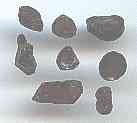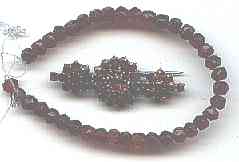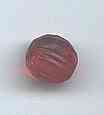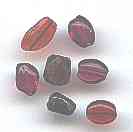 |
The Bead Site =Home>Beadmaking & Materials>Stones > Garnets
The Complexity of Garnets (and Glass)
Garnets have long been favored gemstones. Harder than quartz and brilliant when faceted, their deep colors have attracted humans for millennia.
There is no one garnet. Their composition can be expressed by the formula 3X-2Y-3Z-12O. The "O" is oxygen, but the X. Y. and Z can be any of several different metals, leading to five or six (depending on whom you believe) "species".
Rarely is a garnet stone a pure example of one of the species.
|

|
Chunks, flakes, and a broken bead from the "mother" bead site, Arikamedu, India. Most garnets there are quite pure almandine. The two pieces on the bottom are hessonite, which could have come from Sri Lanka or Vietnam.
|
|
The famous garnet in Europe was the brilliant red pyrope from Bohemia. The pin is an example of their jewelry. To prevent Venetian competition the Bohemians found a way to color glass read using gold. The beads on the outside are glass, but faceted by hand to make them appear more real.
|

|
|

|
Once the red glass was established, the Bohemians learned to use it for many beads. This one was made in a tong mold and cut both on the edge of a thin wheel and on the flat side of the wheel.
|
|
Garnets? Maybe. These gemstone beads from Iran might also be spinels or zircons.
All three minerals have overlapping colors and hardnesses. Only laboratory tests can separate them.
|
 . .
|
|
Sorry, but I can't back-light with my current scanner. I know they look dark.
_____________________________________________
Small Bead Businesses | Beading & Beadwork | Ancient Beads | Trade Beads
Beadmaking & Materials | Bead Uses | Researching Beads | Beads and People
Center for Bead Research | Book Store | Free Store | Bead Bazaar
Shopping Mall | The Bead Auction | Galleries | People | Events
The Bead Site Home | Chat Line | Contact Us | Site Search Engine | FAQ
|
 |



 .
.